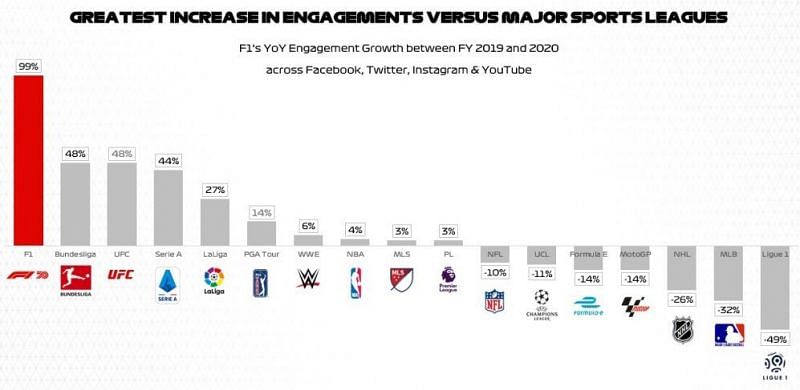Ever since the world got to a standstill amid the COVID-19 pandemic, there is no doubt that Formula 1 has been one of the few industries to experience a spike in its social media audience. According to various reports, the sport has gone as far as beating the likes of Bundesliga (German football league), NBA, NFL, UFC and even La Liga by a wide margin.
In 2019, Formula 1’s social media channels were confirmed to be the fastest-growing of all major sports leagues in the world. This is against UEFA Champions League and the English Premier League that command crazy numbers.
This is crazy to imagine for what is referred to as the ‘pinnacle of motorsport’ that was once regarded as just a niche sport. As an avid viewer and long-time fan, I can personally attest to the crazy engagement that the various Grand Prix races get on Twitter now compared to five years ago.
2020’s events obviously forced the FIA (Fédération Internationale de l’Automobile) to reduce the number of races from 23 to 17. But even then, the sport still managed to maintain an average viewership of 87.4 million viewers per Grand Prix.


Image courtesy F1
In 2021, where everyone is expecting a great upset for the drivers’ and constructors’ championships, there’s no doubt that everyone wants to give an opinion about it. So, who is this growth owed to really?
Netflix’s Drive To Survive
With about a 35% year-on-year follower growth across all social media platforms, one move that really contributed to the hype has to be Drive To Survive. The Formula 1- dedicated docuseries most definitely went a long way into providing fans with an all-access pass into the juicy stuff that goes on and off the track across all 10 teams.
From the Force India (now Aston Martin) politics with former owner Vijay Mallya to the curse that has followed Red Bull’s second driver seat and the subtle feud between teammates, we have seen it all. The series that launched first in 2019 has proven to give a lot of reflection on past seasons as fans look forward to the respective opening season.
In fact, the docuseries has been associated greatly with the growing Gen Y and Gen Z fanbase who were never really interested in the sport before. This deep dive into the stress, anger and effort needed to make just twenty cars race has undoubtedly attracted many into the fold and it’s all for the benefit of everyone and the sport at large.
F1 Fan YouTube Channels
With every growing phenomenon comes an abundance of content creators willing to spark and maintain conversations around it. European football is one of the markets that has witnessed this to an impressive degree. Almost every big club now has several Youtube fan channels where they speak about their players, managers and stream as they watch every single match.
Formula 1 is gradually turning into that with various creatives now dedicating their channels solely to the sport. These channels get to speak about every team and even have chats with viewers on various topics around the drivers and cars. The likes of Tommo (previously TommoF1), WTF1, Aarava, Quadrant and Veloce are just some of the few channels that continue to do this.
The raw reactions and arguments during and after every Grand Prix are one of the factors that have proven to relate a lot more with fans while also bringing on so many more new viewers into the racing sport.
The Drivers
As mentioned before, Formula 1 has in the past been viewed as a highly intellectual and complex sport that should only be viewed by car nerds or those rich enough to be interested. However, the growth has proven that it is a sport that can be understood easily by everyone. This is why the young audience seems to be more and more engaged with it over time.
So with this comes a rising social media popularity for not just the teams but the drivers as well. It is now not crazy to see drivers like Lewis Hamilton garner up more than 23 million followers on Instagram or Lando Norris get an average of 18 million views on his Twitch account. And with the F1 grid getting younger thanks to Charles Leclerc, George Russel and more, there’s no doubt that fans will continue to engage more with the drivers through their personal accounts.
The sports’ audience between the ages of 16-35 is expected to rise to one billion by April 2022, according to global sports analysts Nielsen Sports. So there is no doubt that we will soon see it compete in engagement with football leagues as it already has.
And while there are all these factors Formula 1 can thank, there’s bound to be a lot more that will contribute to an even bigger audience over the next few years.





It depends on your online popularity test grade calculator
It’s fascinating how Formula 1 has transformed its presence through social media—it shows how data and engagement can drive results. Similarly, for students who want to keep their academic performance in check, by visiting the online gpa calculator is a great way to stay ahead with clear insights into their progress.